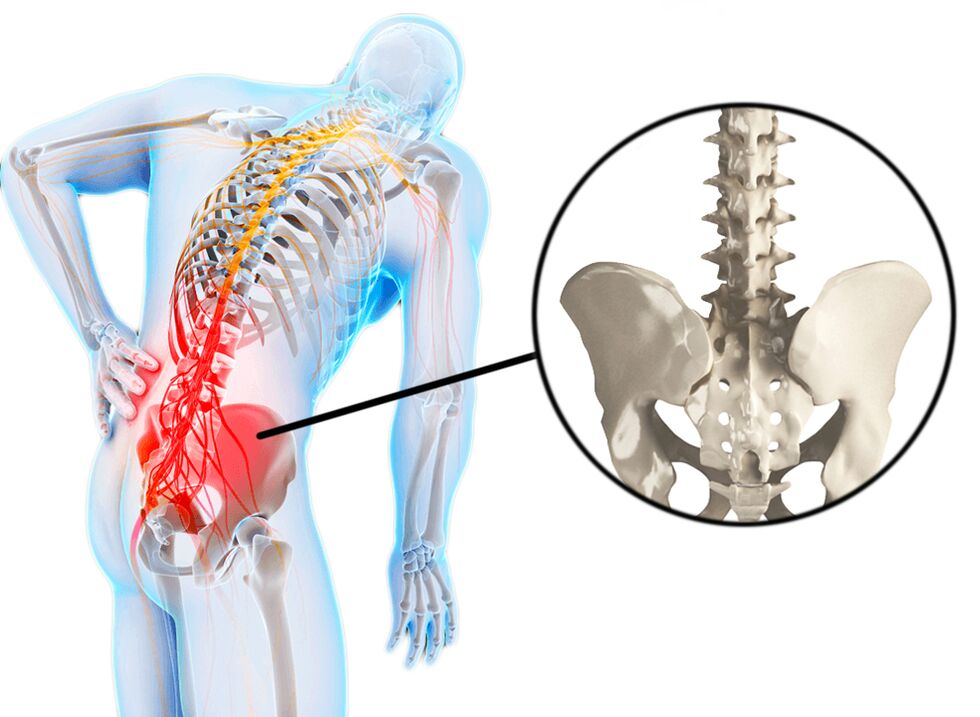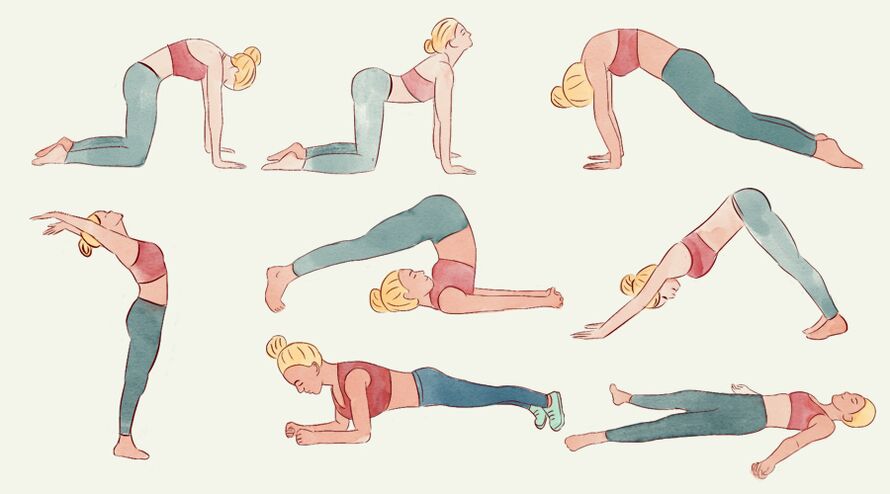
Low back pain is often referred to as lumbago or lumbodynia. Lumbago or "lumbago" is an attack of acute lower back pain that is usually associated with hypothermia and exertion. Lumbago occurs in many people and is often the cause of temporary disability. Often, sports injuries or sprains can be the cause of lumbago, but sometimesthe factor that provokes the appearance of pain remains unknown. Lumbago is characterized by pain that does not radiate into the legs. Lower back pain (lumbago) can be acute and gradually progress during the day. Often there is stiffness in the morning and gradually transformsThe stiffness in a pain syndrome. Curvature of the spine (antalgic scoliosis) due to muscle cramps is possible. The pain itself can be due to muscle cramps, which in turn are related to other causes. These can be overload or sprain, sports injuries, herniated discs, spondyloarthrosis (Spondylosis), kidney disease (infection or kidney stones). Sometimes the patient accurately determines the cause and effect relationship of the occurrence of malaise with exertion and hypothermia, but often pain occurs for no apparent reason. Sometimes back pain can also occur after sneezing, bending over, or shoing. This can be caused by deforming diseases of the spine, such asB. scoliosis, can be relieved.
In contrast to lumbago, the term lumbodynia does not mean acute pain, but rather subacute or chronic pain. Usually, lumbodynia pain occurs gradually over several days. Pain can also appear in the morning hours and decrease with physical activity. Lumbodynia is characterized by increased pain with prolonged static load (sitting, uncomfortable posture). It is also characteristic of lumbodynia that the pain is relieved by lying down in a certain position. Patients with lumbodynia have difficulty performing routine activities such as washing or putting on shoes due to muscle spasms. Due to the disease, the volume of movement of the trunk decreases (leaning forward or, to a lesser extent, leaning to the side or extension). Because of the pain syndrome, the patient often has to change positions when sitting or standing. In contrast to lumbago, muscle spasm is less pronounced and usually does not cover the entire lower back, and there are often signs of a one-sided prevalence of spasms.
Causes of Back Pain
Back pain is a symptom. The most common causes of back pain are diseases (injuries) of muscles, bones and intervertebral discs. Once in a whileBack paincan be caused by diseases of the abdominal cavity, pelvis, and chest. Such pain is called reflected pain. Diseases of the abdomen (e. g. appendicitis), aortic aneurysm, kidney diseases (urolithiasis, inflammation of the kidneys, cystitis), infections of the pelvic organs, ovaries - all these diseases can manifest themselvesBack pain. . . Even a normal pregnancy can lead to lower back pain due to sprains in the pelvic area, muscle cramps due to stress and nerve irritation.
Most frequentlyBack painis associated with the following diseases:
- Compression of the nerve root that causes sciatic symptoms and is most commonly caused by a herniated disc. As a rule, when the nerve root is compressed, the pain is acute, has a radiation and a sensory disturbance in the innervation zone of the nerve root. A herniated disc occurs primarily as a result of disc degeneration. There is a bulging of the gelatinous part of the intervertebral disc from the central cavity and pressure on the nerve roots. From the age of 30, degenerative processes begin in the intervertebral discs. But the presence of a hernia does not always affect the nerve structures.
- Spondylosis - degenerative changes occur in the vertebrae themselves, bone growths (osteophytes) appear, which can affect neighboring nerves, causing pain.
- Spinal canal stenosis can occur as a result of degenerative changes in the spine (spondylosis and osteochondrosis). A patient with lumbar spinal stenosis may experience lower back pain that extends to both legs. Lower back pain can occur as a result of standing or walking.
- Cauda equina syndrome. This is a medical emergency. The cauda equina syndrome occurs as a result of compression of the cauda equina elements (terminal part of the spinal cord). A patient with cauda equina syndrome may experience pain and impaired bowel and bladder function (urinary incontinence and atony). This syndrome requires emergency surgery.
- Pain syndromes such as myofascial pain syndrome or fibromyalgia. Myofascial pain syndrome is characterized by pain and pain at certain points (trigger points), a decrease in the volume of muscle movement in painful areas. Pain syndrome is reduced by relaxing the muscles in the painful areas. With fibromyalgia, pain and aches and pains occur all over the body. Fibromyalgia is not characterized by tightness and muscle pain.
- Bone infections (osteomyelitis) of the spine are rarely the cause of the disease.
- Non-infectious inflammatory diseases of the spine (ankylosing spondylitis) can cause stiffness and pain in the spine (including the lower back), which is especially worse in the morning.
- Tumors, mostly cancer metastases, can be a cause of lower back complaints.
- Inflammation of the nerves and corresponding symptoms of pain (in the chest or lumbar area) can result from damage to the nerves themselves (e. g. with shingles)
- Given the wide variety of causes of symptoms, such as acute or subacute low back pain, it is very important to fully assess the patient and perform all the necessary diagnostic procedures.
Symptoms
Pain in the lumbosacral region is the main symptom of lumbago, lumbodynia, lumboishalgia.
- The pain can radiate to the front, side or back of the leg (lumbar ischalgia) or it can only be localized in the lumbar region (lumbago, lumbodynia).
- The feeling that your lower back hurts may increase after exertion.
- Sometimes the pain can get worse at night or when you sit for a long time, such as during a long drive.
- Perhaps the presence of numbness and weakness in that part of the leg that is in the zone of innervation of the compressed nerve.
For a timely diagnosis and treatment, a number of criteria (symptoms) deserve special attention:
- A recent history of injury, such as a fall from a great height, a traffic accident or similar incident.
- The presence of minor injuries in patients over 50 years of age (for example, falling from a low height from sliding and landing on the buttocks).
- History of long-term use of steroids (for example, patients with bronchial asthma or rheumatological diseases).
- Any patient with osteoporosis (mostly older women).
- Any patient over 70 years of age: At this age, there is a high risk of cancer, infections and diseases of the abdominal organs that can cause back pain.
- History of oncology
- The presence of infectious diseases in the recent past
- Temperature above 100F (37. 7 ° C)
- Drug Use: Drug use increases the risk of infectious diseases.
- Lower back pain worsens at rest: This type of pain is usually associated with oncology or infection, and such pain can also occur with ankylosing spondylitis (ankylosing spondylitis).
- Significant weight loss (for no apparent reason).
- The presence of an acute dysfunction of the nerve is a signal for urgent medical attention. For example, this is an injury to walking, dysfunction of the foot are usually symptoms of acute nerve injury or compression. Such symptoms may require emergency neurosurgical surgery.
- Bowel or bladder dysfunction (both incontinence and urinary retention) can be a sign of a medical emergency.
- Failure of the recommended treatment or increased pain may also make it necessary to seek medical attention.
The presence of any of the above factors (symptoms) is a signal to seek medical attention within 24 hours.
diagnosis
History is important in making an accurate diagnosis as various conditions can cause lower back pain. The time of the onset of pain, the association with physical exertion, the presence of other symptoms such as cough, increase in temperature, dysfunction of the bladder or intestines, the presence of seizures, etc. A physical examination is carried out: identification of pain points, the presence of muscle spasms, an examination of the neurological status is carried out. If diseases of the abdominal cavity or pelvic organs are suspected, an examination is carried out (ultrasound of the abdominal organs, ultrasound of the pelvic and pelvic organs, urine blood tests).
If the somatic genesis of lower back pain is excluded, instrumental examination methods such as X-rays, CT or MRI can be prescribed.
X-ray is the first method of examination and allows you to determine the presence of changes in bone tissue and indirect signs of changes in the intervertebral discs.
CT allows you to visualize the presence of various changes in both bone tissue and soft stones (especially with contrast).
MRI is the most informative research method that makes it possible to diagnose morphological changes in various tissues.
Densitometry is required if osteoporosis is suspected (usually in women over 50)
EMG (ENMG) is used to determine the violation of the conduction of stimulus along nerve fibers.
Laboratory tests (blood tests, urine tests, blood biochemistry) are primarily prescribed to rule out inflammatory processes in the body.
Pain management

After diagnosing and confirming the genesis of the vertebrae with lumbago and lumbodynia, a certain treatment for lower back pain is prescribed.
In the case of acute pain, a rest of 1–2 days is required. Bed rest can reduce muscle tension and cramps. In most cases, when the pain syndrome is due to muscle spasms, the pain syndrome will decrease within a few days without taking any medication just by rest.
Medication. With pain syndrome, drugs of the NSAID group are used. COX-2 inhibitors have fewer side effects, but long-term use of these drugs also carries certain risks. Since all drugs in this group have a lot of side effects, the use of drugs in this group should be short-lived and under the mandatory supervision of a doctor.
Muscle relaxants can be used to relieve cramps. However, the use of these drugs is only effective for a spasm.
Steroids can be used to treat pain, especially if there are signs of sciatica. However, due to pronounced side effects, steroid use should be selective and short-lived.
Manual therapy. This technique can be very effective for muscle blocks or subluxation of the facet joints. Mobilizing the motor segments can reduce both muscle spasms and lower back pain.
Physical therapy. There are many modern physical therapy procedures that can relieve both pain and inflammation, and improve microcirculation (e. g. , electrophoresis, cryotherapy, laser therapy, etc. ).
Exercise therapy. Exercise is not recommended for acute lower back pain. Movement therapy can be added after the pain syndrome has been reduced. For chronic pain, exercise can be very effective in strengthening the muscle corset and improving the biomechanics of the spine. Exercises should only be selected with a movement therapist, as independent exercises can often lead to increased symptoms of pain. Systematic exercise therapy, especially in the case of degenerative changes in the spine (osteochondrosis, spondylosis), can maintain the functionality of the spine and significantly reduce the risk of pain syndromes.

















































